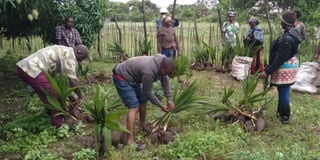National Coconut Week: Tana River initiates strategy to increase the crop's output
Sponsored by County Government of Tana River

Coconut nursery establishment in Tana River County.
County overview
Tana River County derives its name from River Tana, which is the main source of water for the region. The river runs approximately 650km across the county and empties its waters into the Indian Ocean.
The county occupies an area of 39,190.6 square kilometres, and agriculture and livestock production are the main sources of livelihood here, contributing about 82 percent of household incomes and more than 80 percent of employment (County Integrated Development Plan 2018-2022).
Crops farming is mainly along the River Tana basin. The soils range from sandy to dark clay and alluvial deposits, usually deep around the riverine environs, but shallow with hard pans in several parts, and normally susceptible to wind and water or flood erosion.
Tana River is largely hot and dry. Average annual temperatures are about 30 Degrees Celsius. The highest temperatures average 41 Degrees Celsiusin the January-March season, while the lowest is about 20 Degrees Celsius, experienced in June-July.
Rainfall is low, bimodal, erratic and convectional in type. Annual rainfall averages 250-400mm/annum, with long rains occurring in March, April and May, and the short rains in October, November, and December. However, owing to climate change, these seasons are not as definite as before.

President Dr William Ruto (left) and the Governor of Tana River County Maj (Rtd) Dr Dhadho Godhana (next to the President), and other dignitaries, during the launch of an integrated fruit processing plant in Hola town in November 2023.
County agro-ecological zones
- Coastal lowland 3 (CL3): This is non-arid and semi-arid zone along the coastal plain. It is mainly the coconut and cassava growing area, covering Kipini East and Kipini West wards.
- Coastal lowland 4 (CL4): This is the cashew nut and cassava zone, covering Garsen South, Garsen Central, and Garsen West, and coming up to parts of Kinakomba).
- Coastal lowland 5 (CL5): Mainly the livestock keeping/herding zone, largely on the riverine areas of Mikinduni, Chewani, Milalulu and parts of Tana North.
- Coastal lowland 6 (CL6): This is the lowland ranching zone, covering majorly Bangale, Madogo, parts of Hirimani, Wayu, Garsen North (Asa and Kone).
Current coconut production
Coconut production is carried out mainly in the CL3 and CL4 zones. Kipini East ward is the main coconut growing area in Tana River county.
The main coconut variety planted is the East Africa Tall. This is a pioneer variety and has remained so for many years in the Kipini areas.
The County Government of Tana River has over time been the key promoter of coconut production in the county. In 2016/2017, the County Government procured coconut seedlings and distributed to farmers in Kipini wards. That consignment brought in about 15,000 seedlings.
Nature Kenya and Welthungerhilfe (WHH)/Tana River also supported farmers with about 2,000 seedlings in 2020-2022. These were distributed to farmers in Kipini East and West wards. In the same years, Agriculture and Food Authority (AFA) contributed hybrid coconut variety from India.
Key coconut production areas | Estimated area under production (Ha) | Estimated production (mt) | Remarks | |
1. | Kipini East Ward | 200 | 7,500 | Estimated average of 250 nuts/tree/year |
2. | Kipini West | 50 | 1,000 | Estimated average of 150 nuts/tree/year |
TOTAL | 250 | 8,500 |
Future of coconut production in Tana River
The County Government of Tana River is keen to increase coconut production and to exploit its potential as an oil crop, besides its ordinary traditional uses. The tree occupies a special position to local due to its multiple applications. Therefore, there are plans to buy and distribute more seedlings to farmers.

Maj (Rtd) Dr Dhadho Godhana, the Governor of Tana River County.
Hence, in collaboration with Agriculture and Food Authority, Kenya Plant Health Inspectorate Service, Micro-enterprise Support Programme Trust through the Danish Embassy jointly with Kenya Agricultural Livestock Research Organisation, Coconut farmers and academia, there are plans to facilitate the setting up of a local entity for hybrid coconut production in conjunction with the original Indian farm that supplies Kenya with the hybrid seedlings. The county management is keen on this venture to expand acreage and productivuty of coconut.

Ms Mwanajuma Hiribae, the Ag Tana River County Secretary and County Executive Committee Member for Lands, Physical Planning, Agriculture, Livestock, Fisheries, Veterinary Services, and Co-operative Development.
Challenges
Even though coconut has been around for a very long time, the crop faces challenges:
- Frequent droughts in the growing areas. Climate change has worsened the frequency and intensity of drought. Large numbers of trees have died as a result.
- Poor agronomic practices by farmers, compromising productivity and quality.
- Disorganised marketing by small producers.
- Lack of value addition skills among farmers.
- Low investments by most stakeholders.
The usefulness of coconut
Coconut occupies a special place in the kitchen of the coastal people. It has multiple uses in making a variety of dishes that have currently spread beyond the coast region to many other parts of the country.
Beyond cooking, different parts of the coconut tree are used for various purposes, from roofing and cleaning, to making household decorations, among others. No part of the tree goes to waste.


